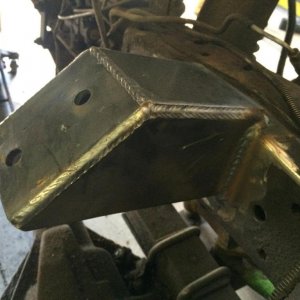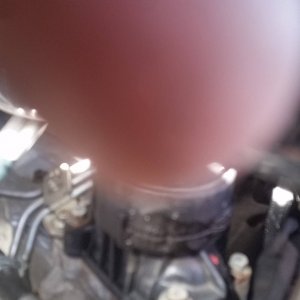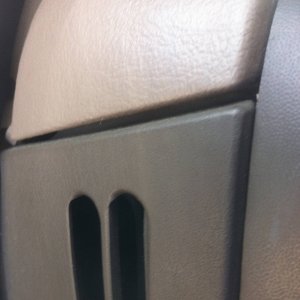You are using an out of date browser. It may not display this or other websites correctly.
You should upgrade or use an alternative browser.
You should upgrade or use an alternative browser.
FFD Rail System
- Thread starter njjeep
- Start date
Chvyrkr
Active member
- Joined
- May 18, 2011
- Messages
- 2,205
- Reaction score
- 1
In theory... This seems like it might have merit.
But, before the 7.3 rolled over to the dark side of the moon the solution being sought was how to move the pressure and volume from the rail into the injector.
I'm just not sure I understand how this is a solution to that, or how this isn't moving that same problem up away from the injector and into the rail.
But, before the 7.3 rolled over to the dark side of the moon the solution being sought was how to move the pressure and volume from the rail into the injector.
I'm just not sure I understand how this is a solution to that, or how this isn't moving that same problem up away from the injector and into the rail.
Chvyrkr
Active member
- Joined
- May 18, 2011
- Messages
- 2,205
- Reaction score
- 1
Oil threads just aren't the same without Chuckie and golfer and the terminator guy... What was his name?
Where are those guys these days?
Have not seen much of them at all the last few years
Hotrodtractor
Moderator
I still chat with Charles on occasion. Its been a while I should give him a shout....
I'm not sure that Dave (Golfer) is in it at all anymore since he no longer owns Swamps Diesel.
I have no idea what Joey or Gary are doing these days.
I'm not sure that Dave (Golfer) is in it at all anymore since he no longer owns Swamps Diesel.
I have no idea what Joey or Gary are doing these days.
blacksmoke.r.us
Member
I just hope the testing has the variables removed from the equation as time and time again there are threads of turbo, injectors, hpop testing etc with no real strict testing. Also it's possible to have a test truck with bran new injectors that have been thoroughly tested to not leak down thru the upper poppet seat which would maintain pressure and go SEE IT WORKS when the majority are running rebuilt clapped out core injectors with shims shoved in compensate for worn out poppet valves that reduce spring preload and leak thru rhe upper seats when the oil is hot.... And many have found shims in their rebuilt FFD Injectors... just saying. A smaller hpop can keep up with correct tuning and quality set of injectors that don't nt bleed oil. Charles ran a set of 400/400s on a 15° stock pump back in the day if I recall. Of course dialed back likely to maintian ICP.
Did Charles' truck run in the 6s?
Not that I am aware his was a street truck. I'm curious for some data. But if it goes like most tests on aftermarket parts there will be tons of variables and no real follow thru or real world testing. Also for most owners not wanting to pull a cab or the engine a upgraded hpop is obviously still much easier to install. This products claims basically go against common logic but and until wowed with information that will likely never surface its all smoke and mirrors. You can easily fudge data in effort to make a profit.
Last edited:
Chvyrkr
Active member
- Joined
- May 18, 2011
- Messages
- 2,205
- Reaction score
- 1
I ran out of time to edit and was leaving work. I was looking at this product incorrectly I see now that these should slide in thru the front of the heads and made two piece for ease of installation.
That just clicked for me too.
From their site.
Installation is very easy. We estimate 45 minutes to 1 hour install time. Simple removal of the oil rail plugs will gain you access to the oil rail log. Slide the back-half of the rail into the oil log, attach and screw together the front half. Slide the rest of the way into the oil log and install the new oil rail plug that comes in the kit.
For some reason I was under the impression that this was replacing the oil rail in the heads... Couldn't get my mind around how, or how that would help.
I'm a lot less skeptical now. Might even have to see if this will help a tired old ADR make it a few more years.
lincolnlocker
Well-known member
Oh wow. I didnt know dave sold swamps!I still chat with Charles on occasion. Its been a while I should give him a shout....
I'm not sure that Dave (Golfer) is in it at all anymore since he no longer owns Swamps Diesel.
I have no idea what Joey or Gary are doing these days.
Hey! You're still alive too!!That just clicked for me too.
From their site.
For some reason I was under the impression that this was replacing the oil rail in the heads... Couldn't get my mind around how, or how that would help.
I'm a lot less skeptical now. Might even have to see if this will help a tired old ADR make it a few more years.
Yep. Its a plug of sorts.
live life full throttle
gwunter
Active member
I wonder how FFD came up with this specific size/area of the log. Bigger log the better? Lol
If the original volume of the head log(less FFD log) is X, Id be curious of what the volume of the new head log would be with the FFD log installed. Does it decrease it by 50%?
Sent from my SAMSUNG-SM-G900A using Tapatalk
If the original volume of the head log(less FFD log) is X, Id be curious of what the volume of the new head log would be with the FFD log installed. Does it decrease it by 50%?
Sent from my SAMSUNG-SM-G900A using Tapatalk
Last edited:
Hotrodtractor
Moderator
Lets make this a little entertaining.
Donate to the ADA using this link: HERE and push my girlfriend over the $1000 mark and I will post my thoughts.
Donate to the ADA using this link: HERE and push my girlfriend over the $1000 mark and I will post my thoughts.
lincolnlocker
Well-known member
How close is she to that mark?Lets make this a little entertaining.
Donate to the ADA using this link: HERE and push my girlfriend over the $1000 mark and I will post my thoughts.
live life full throttle
Hotrodtractor
Moderator
How close is she to that mark?
live life full throttle
I think she is about $100 short right now.
lincolnlocker
Well-known member
Not anymoreI think she is about $100 short right now.
live life full throttle
Hotrodtractor
Moderator
Since my request has been fulfilled - I shall oblige. Thank you - Tamisha was ecstatic.
This whole debate can be boiled quite succinctly down into two issues:
1) Does this thing actually improve performance? Cass said he has evidence to support that it does with improvement in several test trucks as well as years of experience with these trucks. I'm inclined to give him the benefit of the doubt - its no secret that we've known each other for years and consider each other friends. I eagerly await the presentation of said evidence with the rest of you.
2) How does it work? I don't have a a concrete answer on that - but I do have theories which I will outline in a moment. First I'll post a paraphrase of what I told Cass "I know for a fact its not that bull**** you posted on the FB ad" ..... Maybe that isn't actually paraphrasing.... LOL
Theory 1: Firstly - we need to dispel a myth that I have seen repeated in this thread numerous times. Engine oil is compressible. That is a FACT. This is especially true when it comes to aerated oil which is pretty much the only thing that exists in a 7.3L Powerstroke. These rails take up a known volume of the factory "reservoir" giving less volume to be compressed. This could be a method of stabilizing the pressure.
Theory 2: This would be my front runner theory, but its more of an educated guess. These inserts actually dampen the pressure waves that are taking place within the oil rail. Fluid harmonics in a transient flow like this are a PITA. By inserting this device into the oil rail its giving a new surface for the pressure waves mostly being generated by the starting and stopping of oil flow at each individual injector a new surface to bounce off of and dissipate.
Theory 3: I don't have one.... but that doesn't mean there isn't yet another undiscovered mode where this device could improve the rails. If you have theory where this might work - please share.
In any case - if the tech performs as advertised regardless of the the actual physics behind the why it works - that might be what truly matters. While the fluid mechanics of the initial theory that lead FFD down the path to develop this might be fundamentally flawed, it is quite possible that they have stumbled onto something unique and quite worthy of the small price they are asking (compared to anything else for these engines). I think we often forget that sometimes some great things are discovered entirely by accident. Corn Flakes, Teflon, Post-It Notes (the adhesive), silly putty, etc.... were all things created in the pursuit of something else.
That is my take on this. Does it work? Maybe. How does it work? Not as its advertised currently.
This whole debate can be boiled quite succinctly down into two issues:
1) Does this thing actually improve performance? Cass said he has evidence to support that it does with improvement in several test trucks as well as years of experience with these trucks. I'm inclined to give him the benefit of the doubt - its no secret that we've known each other for years and consider each other friends. I eagerly await the presentation of said evidence with the rest of you.
2) How does it work? I don't have a a concrete answer on that - but I do have theories which I will outline in a moment. First I'll post a paraphrase of what I told Cass "I know for a fact its not that bull**** you posted on the FB ad" ..... Maybe that isn't actually paraphrasing.... LOL
Theory 1: Firstly - we need to dispel a myth that I have seen repeated in this thread numerous times. Engine oil is compressible. That is a FACT. This is especially true when it comes to aerated oil which is pretty much the only thing that exists in a 7.3L Powerstroke. These rails take up a known volume of the factory "reservoir" giving less volume to be compressed. This could be a method of stabilizing the pressure.
Theory 2: This would be my front runner theory, but its more of an educated guess. These inserts actually dampen the pressure waves that are taking place within the oil rail. Fluid harmonics in a transient flow like this are a PITA. By inserting this device into the oil rail its giving a new surface for the pressure waves mostly being generated by the starting and stopping of oil flow at each individual injector a new surface to bounce off of and dissipate.
Theory 3: I don't have one.... but that doesn't mean there isn't yet another undiscovered mode where this device could improve the rails. If you have theory where this might work - please share.
In any case - if the tech performs as advertised regardless of the the actual physics behind the why it works - that might be what truly matters. While the fluid mechanics of the initial theory that lead FFD down the path to develop this might be fundamentally flawed, it is quite possible that they have stumbled onto something unique and quite worthy of the small price they are asking (compared to anything else for these engines). I think we often forget that sometimes some great things are discovered entirely by accident. Corn Flakes, Teflon, Post-It Notes (the adhesive), silly putty, etc.... were all things created in the pursuit of something else.
That is my take on this. Does it work? Maybe. How does it work? Not as its advertised currently.












